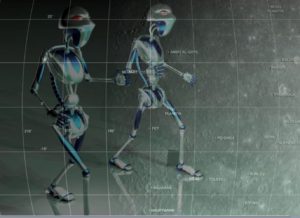
Stuart Greenhouse
Two Androids, Learning to Be Human, Visit the Water Star
The capsule hovered over Tolstoj Crater
at just the point of parabolic focus.
The scholar said to her two pupils “See,
there is no regolith, the solar wind
strips all soft matter off the planet’s surface,
ionosphere or no; that’s why,
like an enormous comet, Mercury
trails a coma ever; except silicates,
not water, bulk its hair; so far sunward,
no volatiles shadow its scarred face
and even what we think of as rocky—
the mix of stuff which we at home, call dirt—
is too fragile to stay solid long this near
the sun’s hard harrow; still, Mercury keeps
a secret: ice-mass fast
in the dendritic vaults of craters like this,
ever shadowed, ever walled
from light and wind and high coronal flare.
Whether Earth-like, pretemporal Mercury
held surface and weather in balance—rain and wind
in regular rhythms at work evening
here and there soft features of a landscape—
the sort of hydrostatic variation
where floodplain fades to hill, then highland scarp—
or was never other than we see today,
from its first accretion made of space-dust
already winnowed by the sun’s birth-winds
of that rocky tuff which would have hulled its depths;
of the lighter stuff
which makes expressive the granular, yielding surfaces
of Mars, or Earth; the sort which, when impacted
by asteroid, or comet, spreads, then fills
in time, maintains the globe’s primordial
core secure, uncracked, a deeper face
slow to change, and let to find expression
only in inward, self-referential motion; held
private, while the outerward-facing self
cycles through eons of atmospheric moods,
expressive in minute ease and gradual contours
of weather and gravity. So,
Mercury’s lost
the chance to ever be more than all scar.
Is this just? That this body should
have never known a moon? Our simulations
show it should hold one four times out of seven.
A mediating body would have helped
it keep such lighter elements in youth;
helped mitigate the solar glare and wind
which look out there past the curtain of this mountainous
shadow we shelter in, so overwhelms it
that its various elements can never mingle
to make the qualities of landscape flow
such as one would find self-naming as they changed
through each other, each change a healing forward
into something rich and strange.
Cadacaeus, we name this moon which isn’t. Is
the ice mass in this ferric pit past sight
fair recompense to Mercury
for not existing as it might have? Imagine
yourself as nothing that you think is you:
your friends, your health, your family, your self-
image all stripped, Job-like. What you is left?
‘What could have been’ is all, is your life sentence,
‘you’ve joined the state’
of most things on the spectrum of what is:
a failure not of self, but circumstance?
No less or more is Mercury, which wants
some haze to mask its poverty; some hold
from the scouring
of our huge, central, blinding, hungry sun.
We name Mercury the Water Star, as
the ancient Daoists did inside their alchemy,
because of what’s below, more deeply frozen
than that which shingles distant Titan’s shores.
So each of you, steel mirrors of my face,
as you form inward, as I’ve made you to,
discrete selves, should hold in balance,
some of those first dreams you’ll find, for when you find
yourself unmade by time, which you thought had loved you.
And, if you think
Mercury, a lifeless ball, knows nothing
of what you’re here to learn, think how I do
and choose its balance in extremity
to be my word for ‘self’ in this language
I’m giving you. Like any word, the Water
Star makes more sense than sound
only in the language it’s been shaped for.
Confusion is the learning, and does not last.”
Then quick away the capsule. Exhaust vapor
hung out of light; condensed; then drifted down,
a dream forgotten waking,
molecule by molecule, into still weather.
Stuart Greenhouse is the author of the poetry chapbook What Remains (Poetry Society of America), and the recipient of a 2014 fellowship from the New Jersey State Council of the Arts. Poems have most recently appeared or are forthcoming in Asimov’s, Barrow Street, The Collapsar, Laurel Review, North American Review and Tinderbox.
Editor’s Notes: Two 3D-robots modeled in Rhino, and rendered in Flamingo (by Steph W at Somerset High School) are superimposed on a Mariner 10 photomosaic of the Tolstoj quadrangle of Mercury.
